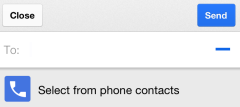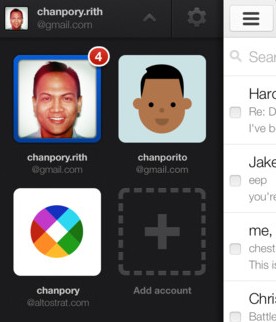1. The native app is faster. Almost everything is faster, from transitions to scrolling and loading messages. This is especially noticeable if you have an old iPhone (I've tested the native app and the web app on an iPhone 3GS: the web app was a lot slower).
2. The native app supports push notifications. If you buy a new iPhone or iPad right now, the Gmail app is the only way to receive notifications almost instantly. The Exchange-powered Google Sync is no longer available for new devices (it still works for existing devices and Google Apps for Business/Education).
3. Gmail's iOS app opens links inside the app, while the web app opens links in a new tab. The first approach is better because it's much easier to go back to the message. You can open pages in Chrome from the Gmail app and Chrome adds a new button that sends you back to the Gmail app, replicating an Android feature.

4. You can preview photos before attaching them to a message in the native app, but this feature is not available in the web app. Photos sent using the native app are a lot more compressed: I've sent a screenshot using both apps and the native app attached a 91KB JPG file, while the mobile Gmail site attached a 239KB JPG image.
5. The native app doesn't show Google's navigation menu and doesn't include browser controls, so there's more space for displaying messages.
6. Gmail's iOS app has a different navigation interface borrowed from the YouTube and Google+ apps. It supports gestures, it's faster and it doesn't replace the current view.
7. The native app integrates with your phone contacts. That means you can open the system contact picker when composing a new message.

8. The web app shows status messages at the bottom of the window, while the native app doesn't.
9. The web app asks for permission to increase local storage to 10MB or more, while the native app doesn't.
10. Both apps let you switch between multiple accounts, but the native app has a nicer interface with profile photos and unread mail counter.


New Google Interface Experiment
ReplyDeleteI still have a problem with this app because it's so helpful in caching the email and making it available offline.
ReplyDeleteOur enterprise needs to help users find an app that doesn't cache email or keep corporate data on their personal devices when accessing our corporate email in Google Apps. The Gmail mobile site works fine for this but it'd be great to find an app that doesn't cache but does do push notifications.
It also lets you get around the Google Apps for Business restrictions on email. On Android I can't get my work email in the Gmail App, in the IOS Gmail App you can!
ReplyDeleteWhere is the "Empty Trash" function in IOS gMail app?
ReplyDeleteNice blog to read about the Iphone application development, Iphone Apps Development in Panchkula, Iphone apps developers etc. It’s Really Helpful for people who interested in iphone course, android course, android classes and Android Apps Development Classes. Thanks for sharing such useful information with us.
ReplyDelete
ReplyDeleteMaster in business administration
B Pharma Courses
Technical Education In Punjab
You cannot add attachments like .vcf(Contacts) in the native app on iOS & Android. On Mobile Gmail Site you can email contacts.
ReplyDeleteGreat Post, I really appreciate your effort here. We could surely use it for some help. In addition I would like to share an article: How Much Does it Cost to Develop an Android Application. I think this can be of some help in calculating the cost of your android apps.
ReplyDeleteiPhone application development
Very informative blog, thanks for sharing. Iphone Mobile Application Development in Bangalore | Iphone Mobile App development Companies in Bangalore
ReplyDelete